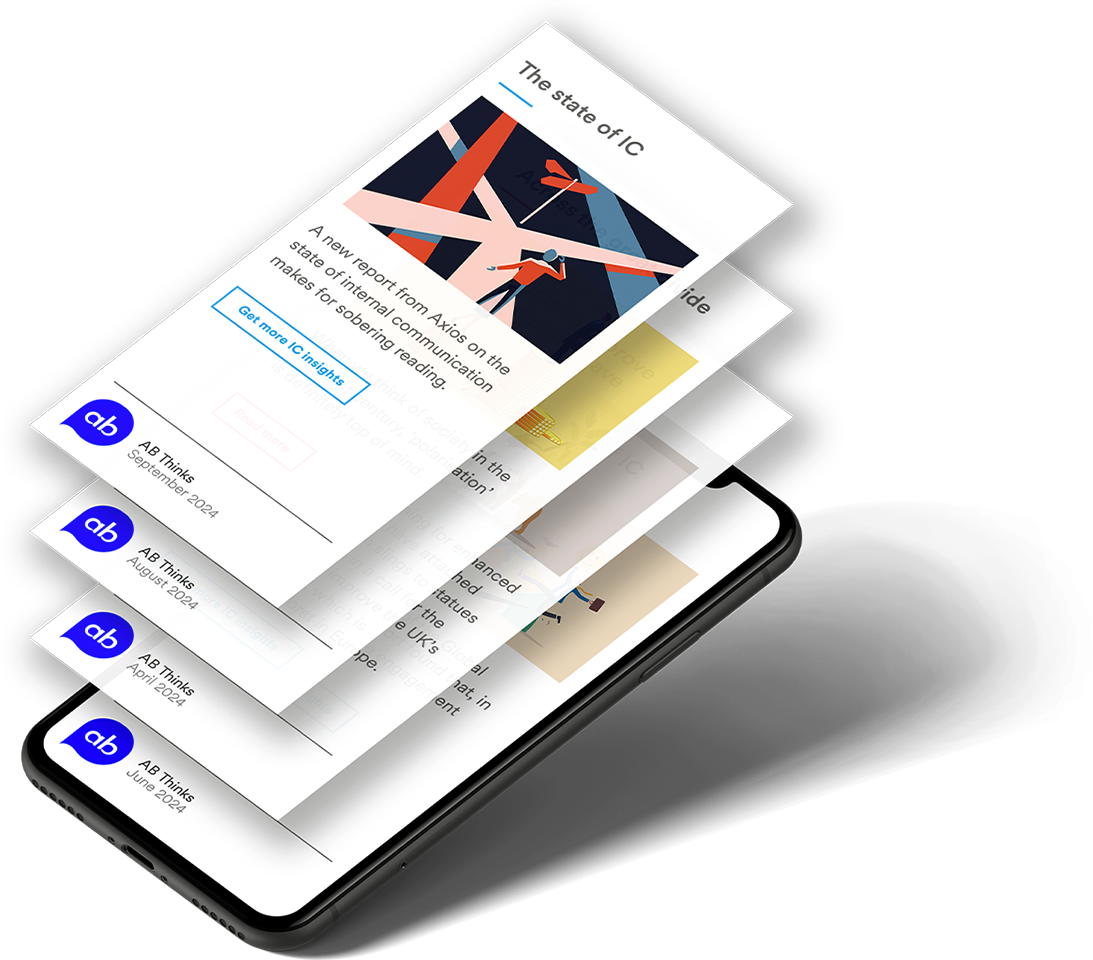A war is waging for our attention. By next year, £1.9 billion will be spent on content marketing across Europe. That’s £5m per day. Much of this content we will deliberately ignore. Much more will get lost in the melee. We are already scrolling through 90 metres of web content every day – the height of New York’s Statue of Liberty, says Facebook’s Regional Director, Ari Kesisoglu.
This has enormous implications for internal communicators. Employees do not owe us their attention. We have to earn it – and that’s never been harder. IC teams often lack the resources and budgets of their peers in other communication disciplines. But a lack of money can be the best spur to greater creativity.
At AB, we believe all great organisations have a great story to tell. Our job is to unearth that story and bring it to life in multiple ways that truly resonate with employees. Here are our eight golden rules for great internal storytelling.
#1 Know (exactly) who you are writing for
In our personal lives, we change the story depending on our audience, otherwise too many of our jokes would fall flat or offend. As internal communicators we have unprecedented access to information about our audience. After all, they are our colleagues, contemporaries and team-mates. We need to use this insight to our advantage and write with someone real in mind. The better we know our audience, the more likely we are to forge a connection.
#2 Be interesting
Let’s be honest, not every new product launch, long service award or annual results announcement makes for scintillating copy. Local newspapers, like internal channels, can struggle to find the showstopping stories. When I moved to the countryside and picked up my local newspaper, a headline ran “New Books in Library”. This may be factually accurate, but it is interminably dull. But behind every unexceptional story, there’s a better one waiting to be found. We just need to look for it.
Take the employee who runs a half-marathon to raise £1,000 for charity. What’s the real story here? Probably the painful, profound experience that motivated her to help others in a similar situation. I might even read about the new books in my library if I also learned about the most borrowed book of all time. Dull writing is lazy. It stems from a lack of curiosity to ask a better question.
#3 Address a problem
Our research tells us audiences are much more likely to engage with content that makes their lives easier. By understanding the pain points employees experience in their day-to-day work, you can build content that addresses real, relevant issues. This gives your content a tangible, beneficial edge.
#4 Start in the middle
“It was a bright, cold day in April and the clocks where striking thirteen.” With the first line of 1984, George Orwell plunges us straight into the action. We know immediately something is awry. A story is not a chronological account. Keep that for your CV.
News writing follows a different rule. Early in their careers, journalists learn about the ‘inverted pyramid’. A story structure where the most important information is placed at the top and the least important at the bottom. As you move through the story, the information becomes less important.
Historically, this made sense. During wartime, saboteurs would cut telegraph lines, so reporters would convey the most important information at the start of their transmissions. Today, it helps readers quickly glean what is most relevant to them.
#5 Conjure an emotion
“I’ve learned that people will forget what you said, people will forget what you did, but people will never forget how you made them feel.” This quote from the Maya Angelou reminds us of the power of eliciting an emotional reaction from our audience. Empathy, fear, compassion, alarm… be intentional with the feeling you want to convey. Rather than tell readers how your hero felt, show them. Don’t tell us he was nervous. Explain how his hands trembled, his heart pounded, and his legs struggled to bear his weight. Now you are creating a picture in our mind’s eye.
#6 Make every word count.
“For sale: baby shoes, never worn.” This six-word story is often attributed to Ernest Hemingway and is a classic example of how much can be conveyed with very few words. Sixty years after Hemingway’s death, digital technology has elevated the importance of brevity. In 1997, the Danish usability guru, Jakob Nielsen, found by cutting copy in half, you could improve usability by 58 per cent. Lose words that do not add value. ‘To all intents and purposes’, ‘first and foremost’, ‘at the end of the day’ and ‘to a certain extent’ can all go. Don’t fear a short sentence.
#7 Get real
I ran a focus group recently with frontline employees who had few kind words about their internal magazine. “Take this quote from a line manager,” said one of the group, “I guarantee he never said: ‘This project helps create better synergies between our various business units.’” He was right. The quote had been massaged. Although more strategically ‘on message’, it had no credibility. A great story is true. Not always because it is factual, but because it is consistent and authentic. There’s no point in a strategically aligned story no one believes.
#8 Have multiple entry points
AB’s creative director Joel O’Connor says: “A picture should not decorate a story; it should help tell it.” Pour an equal amount of creativity into the elements that support your story – whether on screen, digital or in face-to-face communication. Graphics, images, captions, headlines and pull-quotes are entry points to your story. They should be intriguing invitations to pay closer attention.
One of my early editors would often complain my headlines were merely labels. I quickly learned to write headlines that added greater value to my stories. My favourite? In 1991 the tenor Pavarotti sang in London’s Hyde Park to an audience of more than 100,000. Despite being July, the heavens opened, and everyone was drenched. The next day, most newspapers ran with an obvious headline about the famous tenor “singing in the rain”, except one UK broadsheet which rewarded readers with: “Rain in most arias”.
Content with Purpose workshop
AB’s Content with Purpose workshop is on Wednesday 9 October in AB’s offices, near London Bridge. It is designed exclusively for IC practitioners wanting to improve their storytelling skills and develop greater confidence.
We cover how to plan, research and write bolder, braver content that aligns with your organisation’s goals and truly resonates with your audiences. We explain how to create a content with purpose framework, how to set-up and run an effective IC newsroom and where to seek inspiration to develop your story writing capabilities.



